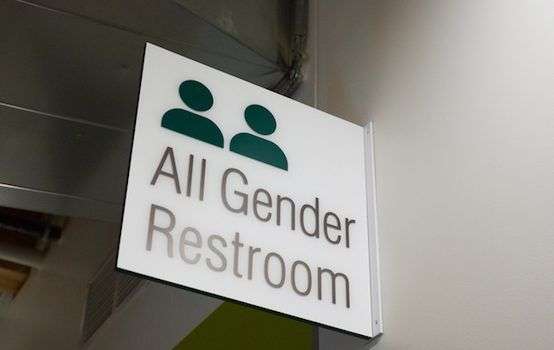
While Western aid organizations advocate for sanitary, sex-segregated bathrooms in developing nations, here at home, legislators are turning their backs on protections for women and girls.
In fact, the worldwide effort to destigmatize menstruation and women’s hygiene has seemingly reversed course in the U.S. and UK. Developed nations are making a U-turn on toilet facilities, and they’re doing it to appease trans advocates.
Without access to sanitary bathrooms, female students across the developing world will spend their time of the month at home, missing class. With education for girls already difficult to obtain for reasons of cost and social expectations, lack of sanitary products and facilities will present another imposing barrier.
We know this. We know this because many international organizations that see to the welfare of our most vulnerable populations tell us so. Oxfam works hard to make education accessible to girls by, as they put it, “raising awareness about feminine hygiene, and ensuring there are girl-friendly latrines in schools.” UNESCO also says that “the solution lies in Menstrual Hygiene Management or MHM. It’s the access to adequate information, preparation, and support with which to manage menstruation in a healthy, safe, and dignified manner.”
Advertisement
Anyone here in the United States care to weigh in on why it’s so important that girls have adequate, accessible, sanitary, private spaces? How about the Washoe County School District in Nevada? There, “newly built elementary and middle schools in the district will have gender-neutral restrooms complete with wall-to-ceiling stalls. All students will share a handwashing station in an open space of the restroom….” Missouri’s North Kansas City School District did the same thing.
In Virginia, former student Gavin Grimm and the ACLU brought suit against Gloucester County Public Schools because the district wanted to keep Grimm from using the boys bathroom (Grimm is female presenting as a male). But Judge Arenda L. Wright Allen of the United States District Court in Norfolk determined that this was a violation of Grimm’s rights. The rights of the other students are irrelevant, apparently. This case is still making its away through the federal courts but it’s already had an impact on how schools are dealing with the issue. Many are pre-empting the courts and putting in gender neutral bathrooms or letting trans boys and girls use the sex-segregated facilities of their choice.
Meanwhile, in Council Bluffs, Iowa, students walked out in a protest that was “sparked by a girl who stated that her privacy was violated by a biological male who ‘recently began to identify as a girl’ using the female bathroom.” The Education Week Research Center conducted a poll of American educators and found that “forty-nine percent thought [students] should use the restroom corresponding to the gender of their birth.” What of the other 51 percent?
At UCLA, a proposed requirement that there be more bathrooms that are inclusive brought backlash from trans and non-binary students, who are concerned that floor-to-ceiling partitions between stalls are discriminatory against trans and non-binary folks, because that’s not how men’s and women’s bathrooms are constructed. In this case, inclusivity isn’t about adequate privacy, but adequate exposure.
- I’m a Feminist Who Was Purged by the Trans Left
- Meeting the Transgender Moment
In the UK, reports suggest that girls are skipping school rather than use the same bathroom as a bunch of boys.
The UK is not a developing nation, and the reason for the overturning of sex-segregated bathroom facilities isn’t lack of money, or because girls are being discriminated against. It’s a sense of duty and compassion to boys who want to use the girls’ loo. Boys who have gender dysphoria and feel like girls, boys who don’t want to use the urinal because it makes them uncomfy about the male reality of their bodies (in Grimm’s case, it is the opposite.)
Even worse is the thought that these bathroom bills are not being pushed through to help children, but by trans ideologues who need there to be gender dysphoric kids in order to justify their own claim to innate transness.
When I learned about periods in fifth grade, I was terrified. I lived in perpetual fear that this horrible thing could happen to me at any moment, especially at school. But at least I knew that, should it come at the wrong time, I would have a safe place to go: the bathroom.
Not so for today’s middle schoolers who have to share that safe space with whoever feels like using the girls bathroom. Certainly, just as Oxfam and UNESCO undertake studies to figure out what is needed to ensure equality of education for girls worldwide, the U.S. and UK ought to investigate the impact of non-sex-segregated bathrooms on girls’ attendance and attention.
The Supreme Court is knee-deep in cases about transgender rights. On one side are gender critical feminist groups and concerned conservatives, while progressive ideologues and trans advocates are on the other. These will be landmark decisions that determine whether or not biological sex is a reality or a fiction.
But women’s bodies are not a lie. Sex-specific bathrooms are a women’s rights and access issue, and succumbing to a minority that wants to feel better by imposing on women’s spaces is a major step backwards for social equality.
Libby Emmons is a playwright living in Brooklyn, New York. She has written for The Federalist, Quillette, and Arc Digital, among other publications. You can follow her on Twitter @li88yinc.
Sourse: theamericanconservative.com






